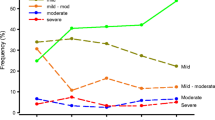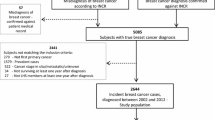Abstract
Purpose
The aim of our study was to establish the prevalence of breast pain persisting 5 years after the initial treatment of breast cancer (BC) and the relationship between those persistent symptoms and general well-being.
Methods
The study involved women from Victoria, Australia, who had survived at least 5 years from diagnosis, remained free from recurrence or new BC and completed the fifth annual follow-up questionnaire. Analysis involved both multivariable logistic and linear regression.
Results
Of 1,205 women, 45 % reported breast pain which persisted for at least 3 months following initial treatment, and of these, 80 % reported pain persisting for at least 5 years. The factor contributing most to the likelihood of persistent breast pain was current lymphedema; however, a full multivariable model explained <10 % of the likelihood of breast pain persisting for 5 years. The presence of breast pain at 5 years was associated with only a modest reduction in general well-being.
Conclusions
Breast pain persisting for at least 5 years after treatment for BC is common. As the pain is largely unexplained by factors associated with the characteristics of the cancer or its treatment, the contribution of patient expectations to persistent breast pain may be considerable.
Implications for Cancer Survivors
Where persistent pain occurs, referral for the management of pain and, where appropriate, lymphedema is warranted.
Similar content being viewed by others
References
Australian Institute of Health and Welfare. (2009) Breast cancer in Australia: an overview, 2009 Cat. no. CAN 46
Lundstedt D, Gustafsson M, Steineck G, Malmstrom P, Alsadius D, Sundberg A, et al. Risk factors of developing long-lasting breast pain after breast cancer radiotherapy. Int J Radiat Oncol Biol Phys. 2012;83:71–8.
Steegers MA, Wolters B, Evers AW, Strobbe L, Wilder-Smith OH. Effect of axillary lymph node dissection on prevalence and intensity of chronic and phantom pain after breast cancer surgery. J Pain: Off J Am Pain Soc. 2008;9:813–22.
Sheridan D, Foo I, O'Shea H, Gillanders D, Williams L, Fallon M, et al. Long-term follow-up of pain and emotional characteristics of women after surgery for breast cancer. J Pain Symptom Manag. 2012;44:608–14.
Miaskowski C, Cooper B, Paul SM, West C, Langford D, Levine JD, et al. Identification of patient subgroups and risk factors for persistent breast pain following breast cancer surgery. J Pain: OffJ Am Pain Soc. 2012;13:1172–87.
Henry NL, Clauw DJ. Thinking beyond the tumor to better understand chronic symptoms in breast cancer survivors. Breast cancer Res Treat. 2012;133:413–6.
Hickey OT, Nugent NF, Burke SM, Hafeez P, Mudrakouski AL, Shorten GD. Persistent pain after mastectomy with reconstruction. J Clin Anesth. 2011;23:482–8.
Lijovic M, Davis SR, Fradkin P, La China M, Farrugia H, Wolfe R, et al. Use of a cancer registry is preferable to a direct-to-community approach for recruitment to a cohort study of wellbeing in women newly diagnosed with invasive breast cancer. BMC cancer. 2008;8:126.
Dupuy H. The Psychological General Well-Being (PGWB) Index. In: Wenger NK, Mattson ME, Furberg C, Elinson J, editors. Assessment of quality of life in clinical trials of cardiovascular therapies. New York: Le Jacq Publishing Incorporated; 1984. p. 170–83.
Armitage P, Berry G. Statistical methods in medical research. Oxford: Blackwell Scientific Publications; 1994.
Gartner R, Jensen MB, Nielsen J, Ewertz M, Kroman N, Kehlet H. Prevalence of and factors associated with persistent pain following breast cancer surgery. JAMA: J Am Med Assoc. 2009;302:1985–92.
Wallace MS, Wallace AM, Lee J, Dobke MK. Pain after breast surgery: a survey of 282 women. Pain. 1996;66:195–205.
Poleshuck EL, Katz J, Andrus CH, Hogan LA, Jung BF, Kulick DI, et al. Risk factors for chronic pain following breast cancer surgery: a prospective study. J Pain: Off J Am Pain Soc. 2006;7:626–34.
Rief W, Bardwell WA, Dimsdale JE, Natarajan L, Flatt SW, Pierce JP. Long-term course of pain in breast cancer survivors: a 4-year longitudinal study. Breast Cancer Res Treat. 2011;130:579–86.
Bell RJ, Robinson PJ, Barallon R, Fradkin P, Schwarz M, Davis SR. Lymphedema: experience of a cohort of women with breast cancer followed for 4 years after diagnosis in Victoria. Aust Support Care Cancer: Off J Multinatl Assoc Support Care Cancer. 2013;21:2017–24.
Bell RJ, Fradkin P, Schwarz M, Davis SR. Understanding discontinuation of oral adjuvant endocrine therapy by women with hormone receptor-positive invasive breast cancer nearly 4 years from diagnosis. Menopause. 2013;20:15–21.
Bruce J, Thornton AJ, Scott NW, Marfizo S, Powell R, Johnston M, et al. Chronic preoperative pain and psychological robustness predict acute postoperative pain outcomes after surgery for breast cancer. British J Cancer. 2012;107:937–46.
Katz J, Poleshuck EL, Andrus CH, Hogan LA, Jung BF, Kulick DI, et al. Risk factors for acute pain and its persistence following breast cancer surgery. Pain. 2005;119:16–25.
Montgomery GH, Schnur JB, Erblich J, Diefenbach MA, Bovbjerg DH. Presurgery psychological factors predict pain, nausea, and fatigue one week after breast cancer surgery. J Pain Symptom Manag. 2010;39:1043–52.
Janz NK, Mujahid M, Chung LK, Lantz PM, Hawley ST, Morrow M, et al. Symptom experience and quality of life of women following breast cancer treatment. J Womens Health (Larchmt). 2007;16:1348–61.
Bell RJ, Lijovic M, La China M, Schwarz M, Fradkin P, Bradbury J, et al. Psychological well-being in a cohort of women with invasive breast cancer nearly 2 years after diagnosis. Support Care Cancer: Off J Multinatl Assoc Support Care Cancer. 2010;18:921–9.
Acknowledgments
The authors wish to thank the study participants and the members of our Study Advisory Group: Dr. Jacquie Chirgwin, A/Professor John Collins, Professor Graham Giles, Mr. Peter Gregory, Mr. Stewart Hart, Miss Suzanne Neil and Mrs. Avis McPhee. The authors also wish to thank members of the research team of the Health and Wellbeing After Breast Cancer study, without whose hard work this large cohort study would not be possible (Maria La China and Jo Bradbury). Finally, we thank Ms. Helen Farrugia, Director of Information Systems, and Professor Graham Giles, Director of the Victorian Cancer Registry, for their ongoing support of this study.
This work was supported by the Bupa Health Foundation (previously the Medical Benefits Fund of Australia Limited Foundation) (to SRD and RJB), the National Health and Medical Research Council of Australia (grant nos. 219279 to SRD and RJB, 490938 to SRD, 1034977 to MP), Novartis Oncology Australia, the L.E.W. Carty Trust, the Jack and Robert Smorgon Families Foundation, Connie and Craig Kimberley and Roy Morgan Research (all to SRD and RJB). This research project was also supported by the Victorian Government through a Victorian Cancer Agency Research Fellowship (to RJB). None of the funding agencies had any role in determining study design; in the collection, analysis and interpretation of data; in the writing of the manuscript or in the decision to submit the manuscript for publication.
Conflict of interest
None of the authors consider that they have any conflict of interest that could inappropriately influence or bias this work.
Author information
Authors and Affiliations
Corresponding author
Rights and permissions
About this article
Cite this article
Bell, R.J., Robinson, P.J., Nazeem, F. et al. Persistent breast pain 5 years after treatment of invasive breast cancer is largely unexplained by factors associated with treatment. J Cancer Surviv 8, 1–8 (2014). https://doi.org/10.1007/s11764-013-0306-6
Received:
Accepted:
Published:
Issue Date:
DOI: https://doi.org/10.1007/s11764-013-0306-6




